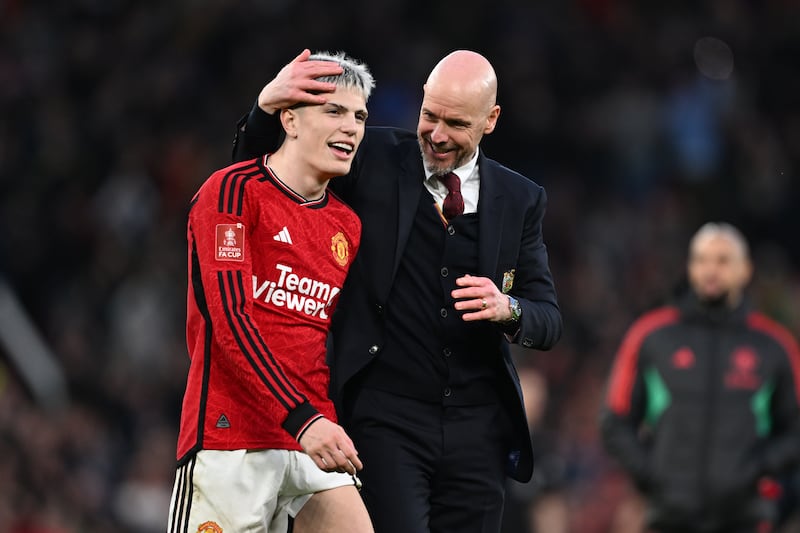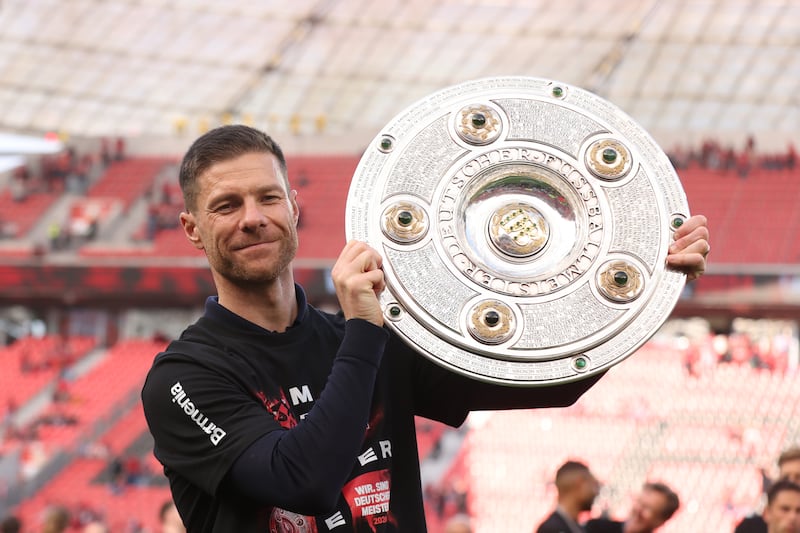The Spanish football gospel has spread to Ireland. Last year, Atlético Madrid, one of Spain’s aristocrats in club football, established a beachhead in the country, setting up an official academy in Dublin. Formally entitled Atlético de Madrid Academy Dublin, it’s the club’s fifth across the world, but its first in Europe. It’s inspired by Atlético’s legendary success and a market opportunity to unearth gifted young Irish footballers.
In the last decade, Atlético have won two La Liga titles and reached two Champions League finals. Their squad is stocked with five World Cup winners – including Antoine Griezmann, Rodrigo De Paul and Nahuel Molina – and Álvaro Morata, Spain’s winning Euro 2024 captain (who will join AC Milan later in the summer). Its most iconic player, Fernando Torres, scored Spain’s winner against Germany in the Euro 2008 final.
Atlético have loaned a full-time coach to Atlético Academy Dublin. All their academy coaches are trained by the Madrid-based club so players learn how to play the Atlético way. Players are also schooled in Atlético’s values, including teamwork, discipline and respect towards referees, guidelines which extend to onlooking parents, who are only permitted to voice encouragement during matches.
Already almost 200 boys and girls have joined the academy. At the moment, Atlético’s academy players train at Abbotstown and Phoenix Park, but this is a temporary arrangement. The academy is looking for a site around Dublin’s hinterland to establish a permanent base with room to grow the academy.

“The lack of appropriate facilities, particularly during winter months, is a significant issue. There has been a comprehensive and enduring failure to provide enough proper facilities for children who want to play soccer in Ireland. We lag so far behind other footballing nations,” says Murrough McMahon, a lawyer and spokesperson for the academy.
As the Atlético academy expands, in addition to having underage teams competing in the Dublin & District Schoolboys’/Girls’ League, its ambition is to have elite teams competing in the League of Ireland. The academy also runs regular football clinics as well as Easter and summer camps and is rolling out coaching clinics to schools.
“It’s an untapped market here in Ireland for a club like Atlético Madrid,” says McMahon. “We’ve two million people in the Greater Dublin Area. According to the Children’s Sport Participation and Physical Study 2022, soccer is the most popular community sport for boys in both primary (56 per cent) and post-primary schools (41 per cent). Participation of girls in soccer has also recently exploded due to the popularity and success of the senior women’s international team, which is fantastic to see, but it has exacerbated the demand for proper facilities.
“The talent is here, but for years no European club would touch Ireland. What happened is that from 15 or 16, kids would go to academies in England, and they’d be scouted there if they were any good by European clubs. Ireland was never perceived as a territory worth exploring from a scouting perspective.”

Dubliner Johnny Carey, who captained Manchester United to a famous FA Cup win in 1948, was lured to Old Trafford as a teenager in the 1930s. After the second World War, talented youths like Liam Whelan, John Giles and Eamon Dunphy followed in his path. Later, other English clubs got in on the act. Liam Brady, for example, joined Arsenal in 1971 as a 15-year-old. Robbie Keane was snapped up by Wolves in 1996 aged 15. Evan Ferguson moved to Brighton as a 16-year-old. None of those deals could happen today.
“There is a gap in the market,” says McMahon. “There has been an unintended consequence to Brexit. It has impacted young Irish players going to the UK. Players in the EU can no longer transfer to England until they’re 18, but Irish players – who are, of course, in the European Union – can still move to European clubs at 16.
“Ireland, though, isn’t on the radar of other European clubs. A few years ago, for example, Irish academy coaches went out to Juventus, and a Juventus executive told them they never had anyone scout in Ireland. The furthest they got to was England because they thought all the promising Irish players would be playing in England. They only ever went to England to scout. That’s changed now because of Brexit.”
From January 2021, according to Brexit legislation, English football clubs could no longer sign under-18 footballers from overseas. The law was designed to limit foreign players joining English clubs. It led to a flurry of transfer activity the year beforehand, as Premier League clubs were conscious that a drawbridge was about to be pulled up.

Manchester United, for instance, swooped for six overseas players aged 16 to 18 in the summer of 2020; the club admitted upcoming Brexit regulations informed its strategy. One of those teenage players was Alejandro Garnacho, who they prized away from Atlético. Aston Villa was another Premier League club which purposefully scouted players aged 16. It signed St Patrick’s Athletic defender Aaron O’Reilly in the summer of 2020 a few days after his 16th birthday.
The profile of Ireland’s under-17 squad is changing dramatically as a result. Last year, for example, only two of the 20 footballers in the Irish squad to play in the European Under-17 Championship finals in Hungary were attached to English clubs: Hull City’s Stanley Ashbee, whose Irish ancestors come from Co Limerick, and Crystal Palace’s Jake Grante, whose relatives hail from Kilkee, Co Clare. The other 18 footballers played with Irish clubs.
This season a trend is developing. Two players from the Ireland squad who played European Under-17 Championship qualifiers in March are signed with clubs in Europe: Matthew Moore at Hoffenheim in Germany and Aarón Ochoa at Malaga in Spain. Most recently, Shelbourne defender Finn Sherlock, who turned 16 in July, also joined Hoffenheim.
Atlético has an interesting historical connection with Ireland: the first stadium it owned, which it used between 1912 until 1923, was Campo de O’Donnell (O’Donnell Stadium). The stadium hosted Spain’s first international football match played in Madrid, a 3-1 victory over Portugal in 1921. It was located close to Retiro park in the heart of Madrid on O’Donnell Street, which takes its name from Leopoldo O’Donnell, a notable military general and politician in Spain during the nineteenth century of Irish origin.
Now it looks like more young Irish immigrants – some of the country’s most talented footballers – might be following in the footsteps of the O’Donnell family south towards Madrid. “When we get set up with our own ground, any budding footballer in Ireland will be dying to get into our academy,” says McMahon, “because of the prospect that if we see someone interesting, we’ll be able to get them straight over to Atlético for a trial.”
♦◊♦◊♦◊♦◊♦◊♦◊♦◊♦◊♦◊♦◊♦◊♦◊♦◊♦

Why is Spanish football coaching so good?
It feels sometimes like Spain is ground zero when it comes to football. A thrilling Spain team just became the first country to win the European Championship four times. A couple of months ago, Real Madrid won its 15th European Cup, an extraordinary dominance in the club game. (AC Milan is next on the list with seven titles.) The top three coaches in the English Premier League come from Spain: Manchester City’s Pep Guardiola, Arsenal’s Mikel Arteta and Unai Emery at Aston Villa.
Xabi Alonso graduated with his Uefa coaching licence in 2019 (in a class that included Xavi Hernández and Raúl, who are both carving significant coaching careers). Alonso devised a deft trajectory for his coaching career, beginning at Real Madrid’s youth academy, then moving on to to coach Real Sociedad’s reserve team before conquering Germany with Bayer Leverkusen, the only champions in Bundesliga history to go undefeated all season domestically.
There is a reason why Spain is so good at nurturing intelligent football coaches. It invests in coaching. In 2017, for example, 15,459 coaches in Spain held Uefa’s two top coaching qualifications, compared with only 2,083 coaches in England. Ireland has only 10 full-time staff spread across 24 academies. In contrast, Croatia with a similar sized population has 190 full-time academy staff across 10 clubs.
The strategy has paid dividends for Spain. In addition to its Euro 2024 success, it’s the only footballing nation to win three major international tournaments consecutively: Euro 2008, World Cup 2010 and Euro 2012. These successes were built on coaching excellence at underage level. Spain, for example, has won the European Under-17 Championship nine times since its inauguration in 1980, more than any other country.





















